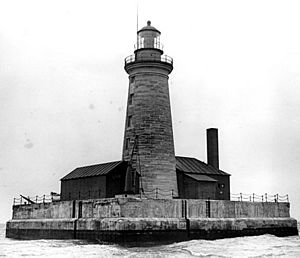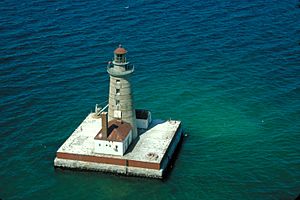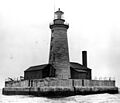Spectacle Reef Light facts for kids
 |
|
| U.S. Coast Guard Archive | |
|
|
|
| Location | Cheboygan County, Michigan, Lake Huron |
|---|---|
| Coordinates | 45°46′24″N 84°8′12″W / 45.77333°N 84.13667°W |
| Year first constructed | 1874 |
| Year first lit | 1874 |
| Automated | 1972 |
| Foundation | cofferdam/timber exposed crib |
| Construction | Monolithic limestone/iron bolts |
| Tower shape | Frustum of a cone on a rectangular house |
| Markings / pattern | natural with red roofs |
| Height | 80 feet (24 m) |
| Focal height | 86 feet (26 m) |
| Original lens | Second-order Fresnel lens |
| Current lens | Solar powered 300 mm Tideland Signal acrylic lens |
| Intensity | 400,000 candlepower white; 80,000 candlepower red |
| Range | 11 nautical miles (20 km; 13 mi) |
| Characteristic | Flashing alternately white every 60 seconds, red every 5 seconds.
Operates year round. 100 candlepower white winter light which flashes every 5 seconds |
| Fog signal | HORN: air–diaphone |
| ARLHS number | USA-782. |
| USCG number | 7-11730 |
The Spectacle Reef Light is a famous lighthouse located about 11 miles (18 km) east of the Straits of Mackinac in Lake Huron, Michigan. It was designed by Colonel Orlando Metcalfe Poe and Major Godfrey Weitzel. This lighthouse was the most expensive one ever built on the Great Lakes.
Building this lighthouse was a huge challenge because it was on an underwater shoal (a shallow area). Workers even had to lay an underwater crib (a timber frame filled with rocks). Because of these difficulties, it's considered one of the "most spectacular engineering achievements" in lighthouse building on Lake Huron. It took four years to build because bad weather meant work could only happen in the summer. Workers lived right at the site in a special structure.
Contents
History of Great Lakes Lighthouses
From 1852 to the early 1900s, the United States Lighthouse Board worked hard to build lighthouses. These lights helped ships travel safely on the Great Lakes. Many new lights were built, especially in the 1870s and 1880s.
Over time, the design of lighthouses changed. Before 1870, lighthouses often had the light on the roof of the keeper's house. Later, taller brick towers were built to make the lights shine higher. By the 1890s, steel-lined towers started to replace older brick ones.
Building on Water: Reef Lighthouses
Between 1870 and 1910, engineers began building lighthouses on isolated islands, reefs, and shoals. These spots were very dangerous for ships. Before these lighthouses, light ships were used to mark hazards. But lightships were risky for sailors and could be moved off course by strong storms. This made them unreliable when captains needed them most.
The Lighthouse Board used special underwater crib designs to build lights in difficult places. Famous examples include the Waugoshance Light (1851), Spectacle Reef Light (1874), and Stannard Rock Light (1882). These projects were big engineering successes. By 1925, most of the Great Lakes lighthouses we see today had already been built. Many of these aids to navigation were becoming automated, meaning they didn't need a lighthouse keeper living there all the time.
Building on shoals was part of a bigger plan to create 14 reef lights around Michigan. These lights helped ships navigate safely through the tricky areas near the Straits of Mackinac.
Building the Spectacle Reef Light
The Spectacle Reef area was first marked with a buoy in 1868. However, many ships were lost there in the 1860s, including two schooners that crashed in 1867. This convinced the Congress that building a lighthouse would save money in the long run by preventing shipwrecks.
The lighthouse is built on a reef that looks like a pair of eyeglasses, which is how it got its name. It's located where many freighter (cargo ship) pass on Lake Huron. More ship traffic meant a greater risk of accidents without better warnings about hazards.
Construction Challenges and Costs
The Spectacle Reef Lighthouse cost $406,000 to build. This was a huge amount of money back then! One big expense was buying a steamer to carry all the building materials to the remote site.
The foundation was built using a cofferdam, which is a watertight enclosure pumped dry to allow construction. This was protected by a massive crib made from 12-inch-thick (0.30 m) timber. The crib was built on slipways (like building a ship) and then towed by tugboats to the reef. It was then sunk and grounded 11 feet (3.4 m) below the surface. This huge crib created a safe area for the cofferdam, a wharf (dock), and living quarters for the workers. Once the water was pumped out, the masonry (stone work) was laid directly on the bedrock.
The construction took 20 months of actual work, but it was spread out over four years (1870–1874). This was because no work could be done during the winter, and most of spring and fall, due to severe weather.
The nearest land, Bois Blanc Island, was 10 miles (16 km) to 12 miles (19 km) away, and not suitable for a staging area. So, all the construction happened right at the lighthouse site. A temporary Fresnel lens was even installed on the roof of one of the worker buildings. The lighthouse was almost finished by the fall of 1873, but winter storms forced workers to leave. Work started again in the spring of 1874. The lighthouse was completed in June 1874 with a new second-order Fresnel lens, and it began operating.
Battling the Ice
The lighthouse's location means it faces strong waves and huge ice fields. Lake Huron's drift ice can be over two feet thick and cover thousands of acres. These massive ice sheets create an "almost irresistible force." However, the Spectacle Reef Light was designed to stand strong against the ice. The structure crushes the ice and slows its movement, causing it to pile up on the 7 feet (2.1 m) shoal. This creates a protective wall against other ice fields.
The tower is shaped like a "frustum of a cone" (a cone with the top cut off). Its base is 32-foot (9.8 m) wide and rises 93 feet (28 m) above the water, with 11 feet (3.4 m) below the water.
The Coast Guard explains that the light's focal plane (where the light shines from) is 86 feet 3 inches (26.29 m) above the water. The tower is solid for 34 feet (10 m) up, then becomes hollow with five rooms inside. The walls are very thick at the bottom, tapering to 16 inches (410 mm) at the top.
The stone blocks are 2 feet (0.61 m) thick and interlocked. They are fastened with strong wrought iron bolts that are 2+1⁄2 inches (64 mm) thick and 2 feet (0.61 m) long. The tower is also bolted to the foundation rock with 3 feet (0.91 m) long bolts. After the stones were in place, they were filled with portland cement, making the tower feel like one solid piece, or a "monolith."
The stones were cut and fitted at a special depot 16 miles (26 km) away. They fit so perfectly that each layer could be laid in just three days. The light is known as "the best specimen of monolithic stone masonry in the United States" and "one of the greatest engineering feats on the Great Lakes."
In September 1872, a severe gale (strong wind storm) damaged the lighthouse, requiring expensive repairs. When keepers returned in the winter of 1873–74, they found ice piled 30 feet (9.1 m) high against the tower, 7 feet (2.1 m) higher than the doorway! They had to cut away the ice to get inside.
The lighthouse also has a fog signal building, an oil house, and a storage building. There are also davits (small cranes) to raise and lower boats.
A model of the Spectacle Reef Light was shown at the 1893 World's Columbian Exposition (World's Fair) in Chicago, Illinois. The successful design of the crib foundation and solid stone masonry was later used for the Stannard Rock Light in Lake Superior in 1878.
Current Status and Visiting

The original second-order Fresnel lens (made in Paris, France) was removed in 1982. You can now see it on display at the Inland Seas Maritime Museum in Vermilion, Ohio. Since then, a modern acrylic lens has been used, and the Spectacle Reef Light continues to help ships navigate today.
In July 2005, the "Spectacle Reef Light Station" was added to the National Register of Historic Places.
The Spectacle Reef Lighthouse was one of five lighthouses featured on a "Lighthouses of the Great Lakes" postage stamp series in 1995. One lighthouse was chosen from each of the Great Lakes.
As of July 2015, the light was put up for sale through an online auction by the GSA.
Getting There
The lighthouse and its crib are not open to the public. You can only see it up close by private boat. It's a long way from shore in open, sometimes dangerous, water with many shoals.
Shepler's Ferry Service from Mackinaw City offers lighthouse tours in the summer. Their "Eastbound Tour" includes a pass by the Spectacle Reef Light. You can also charter a seaplane for a tour of the area. The Great Lakes Light Keepers' Association also runs an annual "Grand Light Tour" that includes a visit to the Spectacle Reef Light.
Images for kids
-
Undated aerial view by USCG





